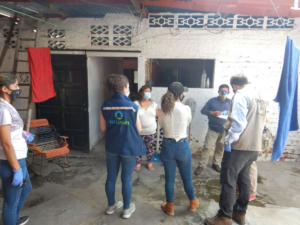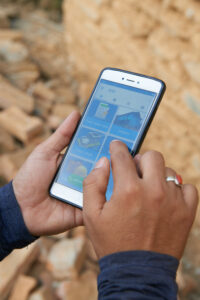Nohelia Rosa Torres Barrientos lived in a structurally unsafe house in the El Picacho neighborhood in Medellin, Colombia. In a seismically active country like hers, this was a problem.
Nearly 750,000 deaths have occurred around the world between 1998-2017 from earthquakes alone, according to the World Health Organization. More often than not, it’s not the earthquake itself that kills people: A poorly built building that collapses under the strain is to blame. This is the premise that drives Build Change, a nonprofit organization whose mission is to prevent housing loss caused by disasters such as earthquakes and typhoons. Founded in 2004 and based out of Denver, Colorado, Build Change’s employees work on five continents. Most of the organization’s support comes through contracts, although it also receives a significant share of support from grants and contributions.

Torres Barrientos worked with Build Change to retrofit her home so it would be ready to withstand the next disaster. She applied for—and received—a home improvement subsidy through Instituto Social de Vivienday Hábitat de Medellín, a local partner of Build Change and part of the Mayor’s Office of Medellin.
To help other global citizens like Torres Barrientos, Build Change leans on advanced artificial intelligence (AI) to attend to the grunt work involved in restructuring at scale, says Noll Tufani, chief operating officer at the organization.
Scalable technology for a gigantic problem
Three billion people will need adequate and affordable housing by 2030, according to the World Bank, most of them in developing countries. Poor construction safety standards, high population density, non-compliance with regulations, and haphazard development contribute to this challenge. “The problem is gigantic,” Tufani says.
Unless we provide a solution that’s effective and scalable and has a strong possibility of success, decision-makers won’t bank any political capital on it.
—Noll Tufani, chief operating officer of Build Change
An additional obstacle: the frequent lack of political will. “To break the news to the population that your home is not really as safe as you think it is, the government has to acknowledge that it didn’t provide the right inspections or do due diligence—and that’s politically risky,” Tufani points out. Instead, government officials like to build new housing projects with a lot of fanfare that might buy them currency among voters.
While new housing might be the more glamorous option, it’s often cheaper and easier for citizens to retrofit existing buildings. “Unless we provide a solution that’s effective and scalable and has a strong possibility of success, decision-makers won’t bank any political capital on it,” Tufani says. AI delivers that solution.
AI as a construction aide
Build Change trains AI systems to determine which houses are good candidates for retrofitting and which ones are not. Retrofitting a home usually involves connecting a series of reinforced concrete columns and beams to existing walls in the structure. Effective retrofitting depends on the number of openings (such as windows) in the house, the distance between these openings, how much solid wall is between them, among other considerations.
To create this solution, the first step involved engineering. After the 2015 earthquake in Nepal, Build Change created categories of retrofit solutions for different typologies of houses commonly seen in rural areas of the country. Based on this pre-engineering, Build Change knew which typologies would be a fit for retrofitting and which would not. “We then used parametric 3D-modeling to generate thousands of images representing houses that meet our pre-engineered typologies,” Tufani says, “And then, using these artificially generated images along with some real images, we trained a machine learning model to be able to visually assess a house as a ‘go’ or ‘no-go’ for retrofit using a mobile app from a simple photo,” he adds. An answer about retrofitting spits out in minutes.
Time and resources are particular challenges without such a system. “Engineering professionals would have to evaluate each house and that’s going to take time,” Tufani says. “It prevents people from having a large, quick brushstroke they can apply to a particular problem and it forces them to get into very specific solutions. That freaks people out because they think solutions will be complicated and expensive.” Applying the AI filter is a good first pass at screening out the homes that are beyond the point of retrofitting so engineers on the ground can focus attention on the ones that can be saved.
AI for post-disaster reconnaissance
While Build Change campaigns to retrofit homes before they’re hit by disasters, much of the organization’s work focuses on post-earthquake rebuilding. The organization had a significant presence in Nepal after the 2015 earthquake which killed 9,000 and injured more than twice as many people.
Efficiency and consistency are the main reasons to use AI to assess structural damage after an earthquake.
—Shirley Dyke, professor of mechanical and civil engineering at Purdue University
Earthquakes are especially challenging as you’re racing against time, says Shirley Dyke, professor of mechanical and civil engineering at Purdue University. “Efficiency and consistency are the main reasons to use AI to assess structural damage after an earthquake,” she says. The AI model that Dyke has developed at Purdue helps rescue professionals on the ground categorize the kinds of damage quickly. Earthquake damage presents itself in different ways, from long cracks to column buckling, for example. Efficiently sorting what you see on the ground into these buckets can provide clues about what to do next. “We developed a tool where they can just drop data in and get it all organized in minutes instead of hours,” Dyke says. AI attends to this time-demanding process so engineers on the ground can quickly determine the next steps.

Build Change also uses AI in a similar way after an earthquake in conjunction with a proprietary mobile app. Homeowners can take pictures of their house, answer a couple of questions addressing the method of construction and size, and upload them to the cloud. Build Change’s AI algorithms then process the picture and give a simple go or no-go for retrofit. In places like Nepal, with mountainous regions and scarce technical resources and money, such on-ground solutions save a lot of time and money.
“Access to Wi-Fi can be a challenge,” Tufani says. “That is why all of the solutions we design work with internet access or without. Someone working in an area without internet access simply syncs after they return to a location where they can access the internet.”
Local solutions for locals
Retrofitting or other home-modification solutions are often indigenous to the region and take homeowners’ desires into account. Build Change might use the same local materials, but suggest more technically sound solutions for building new structures. Meanwhile, social and cultural aspects also factor into the equation. Many Nepalese, for example, love a porch out front, explains a Build Change engineer, so that might be an important structural factor to consider.
In the future, expect more engineering information to be frontloaded onto apps so homeowners can complete the preliminary, retrofitting assessment autonomously. As urban population density and infrastructure needs explode, technology is poised to help the Global South do more with less.
Lead photo courtesy of Build Change